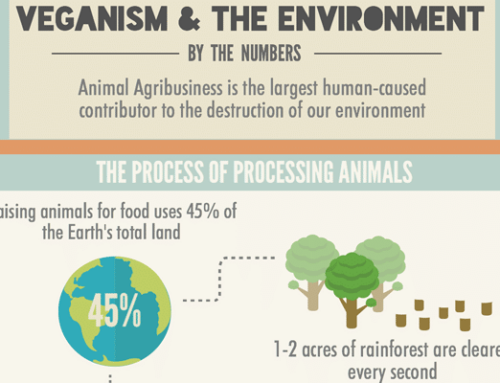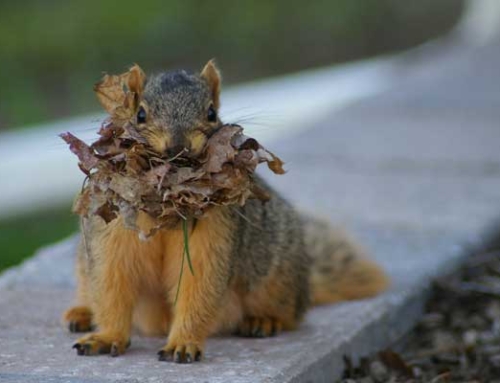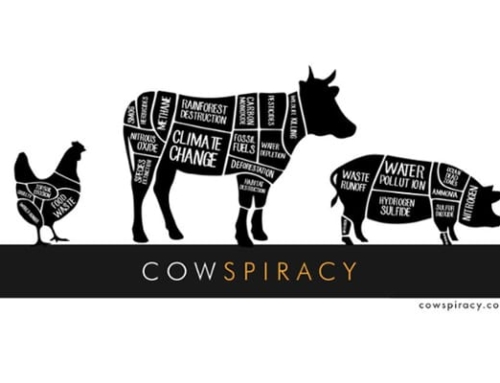Ecology 101: Trophic Levels – What Level Are You?
Disclosure: This post may contain affiliate links
Ethical vegans will argue that killing any animal is immoral, and I certainly agree! However, there is another moral issue here regarding the planet’s resources and all humans.

What's in this post
Share This Story!
Ecology 101: Trophic Levels – What Level Are You?
By Amanda Crow, Guest Contributor
Although farming was once a way of life for many people in this country, today most of our food is produced by a very small number of farms. Ironically, we all know many non-vegans that supposedly live down the road from a local farm because that is their rebuttal to why eating animals is wrong, cruel, gross, etc. Ethical vegans will argue that killing any animal is immoral, and I certainly agree! However, there is another moral issue here regarding the planet’s resources and all humans.
Because I was formally trained in ecology and evolution, I also look at eating animals from an ecological perspective. Ecology is the study of nature as a whole because lots of components (plants, animals, bacteria, soil, environmental factors, etc.) “work together” to create an ecosystem and should be studied as one. The scale of an ecosystem is as broad and narrow as one can imagine, and scientists analyze ecosystems in numerous facets.
Trophic is defined as anything relating to eating/food/nutrition, so ecological trophic levels are divisions that animals fall into according to what they eat. So to speak, the “food chain” is comprised of trophic levels. The different steps or levels are quite simple. Primary producers are at the bottom making their own food – a great example being plants! In case you fell asleep during the botany portion of biology, plants are primary producers because they directly use the sun’s energy to make “plant food” via the process photosynthesis. The next step in the food chain is primary consumers, which cannot make their own food and must eat primary producers. As far as we are concerned here, secondary consumers are the top level; therefore, they eat plant-munching animals.
Ecologists use trophic levels to analyze (chemical) energy transfer within an ecosystem. We now know the general rule of thumb is that only 10% of energy intake is available from one trophic level to the next. A plant needs lots of energy to grow and maintain, but when it is eaten by an herbaceous creature, only a small amount of total energy can be utilized by the herbivore’s body. Then, a predator may eat that creature and still can only utilize a very small amount of energy that was required to grow and maintain the herbivore. Overall, A lot of energy is used then lost between photosynthesis and secondary consumption.
Let’s put this framework over humans’ dietary habits. Plants are the primary producers. Humans can be primary consumers (vegans) or secondary consumers (non-vegans). Without knowing any specific math, we can understand that there is a HUGE difference between the total energy required to produce food for vegans and non-vegans. Vegans are eating at the lowest possible trophic level and are only consuming primary producers aka plants; non-vegans eat a large quantity of primary consumers aka cows, pigs, goats, chickens, etc. This means those farm animals, the primary consumers, require a ton of energy to grow to the point where they can be eaten by the secondary consumers. Since only a small amount of the energy that goes into raising the animal is actually available the next trophic level, animals are a very energy-intensive food compared to just eating plants directly.
The worst part? Humans require (or are highly recommended) an extensive intake of nutrients: vitamins, minerals, phytonutrients, antioxidants, fiber, protein, fats, and carbohydrates. However, the energy gained from eating animals is pretty much only protein and (undesirable) fats with a huge side of cholesterol. The required nutrients are mostly only found in plant sources and cannot be “passed on” through eating a plant-munching creature. In other words, humans still have to eat plants to live!
So back to the moral question of eating animals raised at that neighboring farm…
It does not matter if you do this in your backyard (as many have learned the hard way), raising animals still takes a huge amount of energy with an extremely low yield of return. With our planet covered in humans, one third of whom are starving, there is absolutely no sustainable way for all humans to eat necessary energy requirements to live, let alone thrive, as secondary consumers. Actually, I will argue that even the relatively small number of secondary consumers is still using an unsustainable amount of resources. From a basic human rights stance, using plants to feed animals is directly taking food humans could and should be eating. Because our food comes from a controlled, agricultural source, it isn’t just about the actual plants fed to farm animals. Raising farm animals take a HUGE amount of water, land, food, and oil (as energy for machines, transportation, etc.).
I’ve noticed people respond to this with arguments about economics or resource availability in certain countries (you know, since we are rich and “deserve” more)…well, guess what?
- No one is immune to resource depletion of the planet because as ecology teaches us, every ecosystem has a limit of resource production. You can’t eat your money or guns (well…)
- Those people are assholes that only care about themselves and not the well-being of all humans.
A few disturbing statistics:
- 216 pounds of grain = 1 lb of meat
- 5 gallons of water = 1 lb wheat
As a vegan, I care about all life including all animals – nonhuman and human. Veganism is not just about “animal rights” but also about the rights of all life to live.
RELATED READING: The Environment & Veganism
Photo credit: Tom & Jen






2400 gallons of water= 1 pound of meat. What? Yeah if you’re going to make stuff up then make it believable. Now I’m off to go eat a chicken that apparently took like 30 times more water to raise than a human drinks in a year. Not claiming that number as fact, just throwing it out there and, unlike the author, not stupid enough to confuse my own made up shit with facts.
interesting, but the thing about vegans that makes them kind of cancer, is they dont understand if you ONLY eat what our herbivores eat, you also become competition with herbivores. Meaning, this would indirectly lead to animals dying of starvation anyways. You are basically a herbivore at this point, and then this disrupts the earths biogeochemical cycles just as we already do, or have been. We are part of this cycle here in the biosphere, and one day this planet will end. So might as well come on kill that chicken and make me a sandwhich.
I’m writing a research essay for my English class on vegetarians and i want to cite this article but for the author it just says “guest contributor”? Do I need to know the actual name of the author to cite it on my works cited page or do I just put “Guest Contributor”?
Hi Diana, the author information is listed at the bottom of the article- Amanda Crow. Thank you for stopping by and I’m thrilled we could be helpful for your paper! Let me know if you have any other questions.
Clearly Amanda didn’t get beyond Ecology 101 because if she did she would realize that the the impact of human diet on the environment is far more complex than she portrays from energetics, nutrition, physiological, and environmental perspectives. Vaclav Smil has written an excellent book on the subject of diet, energy and human development. I suggest you read the book before you go vegan and claim a moral victory by becoming vegan and saving the Earth. If you don’t know Vaclav Smil and why he might be more qualified to chime in on this matter, Google him.
Excellent article! This is another great way for me to explain to my friends and co-workers how going vegan not only helps the animals but also the planet. I’ve never thought about this subject from this aspect and it really drives home the point that eating locally raised animals still means consuming more than your fair share of our limited resources.
[…] Ecology 101: Trophic Levels – What Level Are You? […]
Well-thought-out article Amanda, thanks much. Yes, I’ve read about the ecological impact that human consumption has on the planet. Twice, I have been deep in the Amazon rain forest with biologists and its scary to think that this paradise could be substantially wiped out by human intrusion and exploitation. As I understand it, much of the Amazon forest in several countries has been cut down to allow cows to graze so they can head for the meat markets of the world. The grazing is only productive for a year or two because, as these biologists explained to me, most of the nutrients are in the trees and plants and there is only about 1/8 to 1/4 inch of topsoil. Bottom line: More forest must be laid waste to make room for more cows to graze because the soil gets depleted so fast once the trees are eradicated. And, even more ominous, the Amazon forest provides much of the world’s oxygen. Scary.